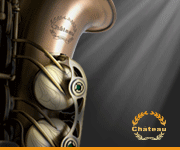 Forgot Username? Forgot Password?
Forgot Username? Forgot Password?
Saxophone Forum |
||
|---|---|---|
Fingering FunOK, fingering differences between the instruments I've played all my life and the sax, which I've played for about three weeks, are driving me a bit nuts. But in a good way. The fingerings of the three groups of instruments are all unique from each other. Additionally, some of the relationships between brasswind and sax fingerings are making this very interesting. I played fingerstyle guitar. Guitar fingering is four fingers on the left hand fingering the notes and chord combinations on six strings (five fingers if you add the thumb reach-over, which I don't because years ago I broke my left thumb and it doesn't bend very well anymore) - with all five fingers on the left hand fingering separate strings and combinations. It gets quite complex. But it's still one hand fingering notes while the fingers of the other hand pick or strum. Brass fingering is three fingers on the right hand, four if you have a compensating instrument. The left hand just holds the horn. Ah, simpler times! :) Saxophone has been a mind-bender for me because both hands finger notes in multiple combinations, along with many different finger combinations pressing and releasing various keys (for example, Eb to E, G# to A - and back - I've never those types of combinations before), and even though the notes are fairly logically laid-out in two stacks, up and down, left and right, I keep finding myself occasionally interspersing brass fingerings on either hand! I've also noticed it becomes a little more complicated between brass and woodwind fingerings for me because of the relationships between fingering certain notes. Low D on brass is the index and ring finger with the middle valve up. I can't tell you how many times I've lifted my right middle finger for a low D on sax. LOL But that's improving fairly easily. Hardly happens anymore. On brasswinds, middle B is the middle finger. On sax middle finger is C, and even though it's the left hand I find myself occasionally fingering middle B with the middle finger of my left hand, sounding a C. Same goes for middle Bb. On brass, it's the index finger. Even though it's the other hand, I find myself pressing the B key for Bb occasionally. Fingering a middle G on brass requires no fingers. All valves are up. On sax, that's a middle C# - without the octave key. Oh, yeah, the octave key. I've never had one of these before. I love it. I can get high range with fairly light pressure. My brass embouchure experience translated to sax regarding pressure, it seems. But sometimes I still forget to press the octave key when needed. Low F on brass is the first finger of the right hand. F# is the middle finger. Great! Right? No. I occasionally transpose the brass fingering in my head by forgetting to close all of the top stack. That's a real hoot when it happens. Literally. I'm trying to practice at least twice daily and usually succeeding. Sometimes three times. I'm beginning scales slowly and I'm sure with more practice I'll gain speed and confidence, and be able to overcome the persistent brasswind infection I've had all these years. For instance, when I'm thinking about tunes I have memorized on brass, I'm beginning to find myself thinking of them in sax fingerings. I also notice that songs I have memorized on brass are easier to play on sax with or without the music. So I guess there is hope. Anyway, the mental workout is fun (especially as one gets older) and when I get the fingering right through a whole exercise or tune, it feels really, really good. Like it felt when I played brass and guitar. It's gotten so I'm afraid to play brass. I might reinforce those fingerings. :D Practice, practice, practice. I'm going to make that my sig. |
||
| Replies | ||
|
||








